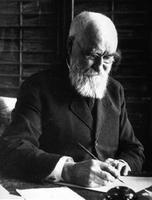
Floras and Botanical Journals
Before 1900 a published "flora" was, loosely defined, a comprehensive, itemized description of the plants of a specific geographical region. Usually more than a mere list, it should have been an analytical description, discussing habitats and distribution and citing previous authorities. This definition did not apply to travelogues, natural histories, botanical art books or popular manuals, of which there were several in Canada by the late 19th century.
Before that time, floras dealing with the area now comprising Canada were published elsewhere and written by botanical explorers and sedentary scholars who identified specimens received from colonial residents, travellers and professional collectors.
Pre-19th Century Journals
Until the 19th century the only published floras containing predominantly Canadian plants were those of Jacques Phillipe Cornut in 1635 (Canadensium Plantarum Historia) and Pierre-François-Xavier de Charlevoix in 1744 (Histoire et description générale de la Nouvelle-France). The manuscripts of Canadian flora known to have been started in the 18th century by Michel Sarrazin, Jean-François Gaultier and Pehr Kalm were not published.
19th Century Journals
Early in the 19th century, André Michaux and Frederick Pursh included more than 400 Canadian locales in their northern American floras, and Auguste Jean Marie Bachelot de la Pylaie wrote a modest flora of Newfoundland but never completed the expected sequel. In 1815 Pursh began collecting for a Canadian flora, but died in Montréal in 1820, shortly after his collection was destroyed by fire.
The era of the itinerant botanical visitor or absentee scholar reached its climax in Canada with William Jackson Hooker, who amassed the collections of explorers, collectors and residents from coast to coast for his monumental Flora Boreali Americana (1833-40). Among his contributors in Québec was a small group of botanizers, including Harriet and William Sheppard, who were encouraged by Pursh, and who also sent specimens to John Torrey and Asa Gray for their Flora of North America (1838-43).
Floras in Canadian Journals
Sheppard, a lumber merchant, did not confine his communications to foreign professionals. In 1829 Canada's first scholarly journal, the Transactions of the Literary and Historical Society of Quebec, contained Sheppard's identifications and popular descriptions of Charlevoix's plants, and in 1831 and 1837 his articles titled "Notes on some of the plants of Lower Canada." Although intended for local amateurs, this pioneer work gave Linnaean classification and synonyms, translated Pursh's Latin descriptive specifications and elaborated on habitats, uses and points of interest.
Botanical articles including plant lists were carried in the Canadian Journal (est 1852) in Toronto, the Canadian Naturalist and Geologist (est 1856) in Montréal, the short-lived Annals of the Botanical Society of Canada (est 1861) in Kingston and the Proceedings and Transactions of the Nova Scotian Institute of Science (est 1863) in Halifax. Their pages frequently announced intentions to compile regional or national floras, but none were published.
Credit for the first extensive flora by a Canadian belongs to another Québec amateur, Abbé Léon Provancher, whose 2-volume Flore canadienne appeared in 1862. Because he openly borrowed numerous illustrations from 2 books by the influential Asa Gray, this flora was seldom cited by contemporary botanists; subsequently, Provancher successfully shifted his scientific efforts to entomology, much of it published in his Naturaliste canadien (est 1868).
Later regional periodicals such as the Transactions of the Ottawa Field-Naturalists' Club (est 1880) and the Bulletin of the Natural History Society of New Brunswick (est 1882) carried detailed local floras as well as botanical notes. The more professional Canadian botanists, such as George Lawson in Halifax, continued to publish articles of high quality abroad or in the Transactions of the Royal Society of Canada (est 1882). Throughout this period, abbreviated floras were appended to many botanical textbooks and manuals published in Canada, and lists of plants from remote regions were included in the reports of the Geological Survey of Canada by such indefatigable field men as Robert Bell and John Macoun.
The ultimate in historic Canadian floras and the first that could compare favourably with the best from abroad was the Catalogue of Canadian Plants, compiled by Macoun and published in 7 parts (1883-1902). Despite its thousands of species, some with descriptions, synonyms, habitats, locales and authorities, Macoun modestly considered it only preliminary to a "Flora of Canada," which would have to await the 20th century.
Nonetheless, the development of Canadian botanical description could be considered to have come of age after a painful adolescence marked by catastrophic losses, disappointed hopes and deplorable neglect. This slow maturation deserves recognition as pioneering scholarship under adverse conditions. See also Botany History.

 Share on Facebook
Share on Facebook Share on X
Share on X Share by Email
Share by Email Share on Google Classroom
Share on Google Classroom

